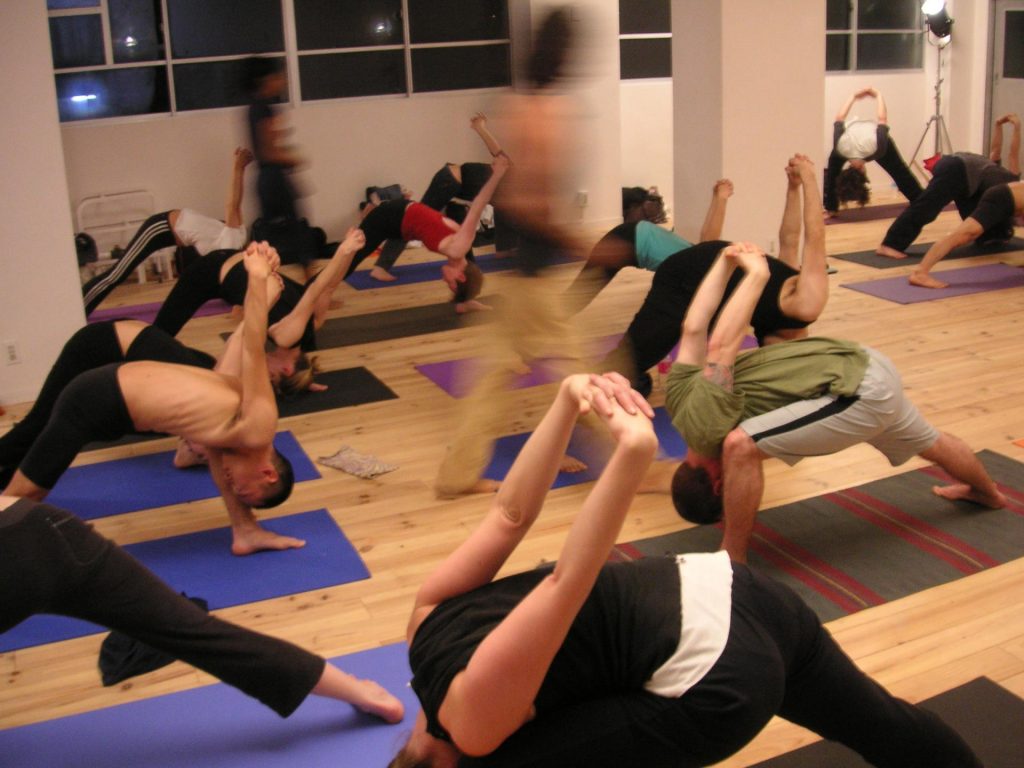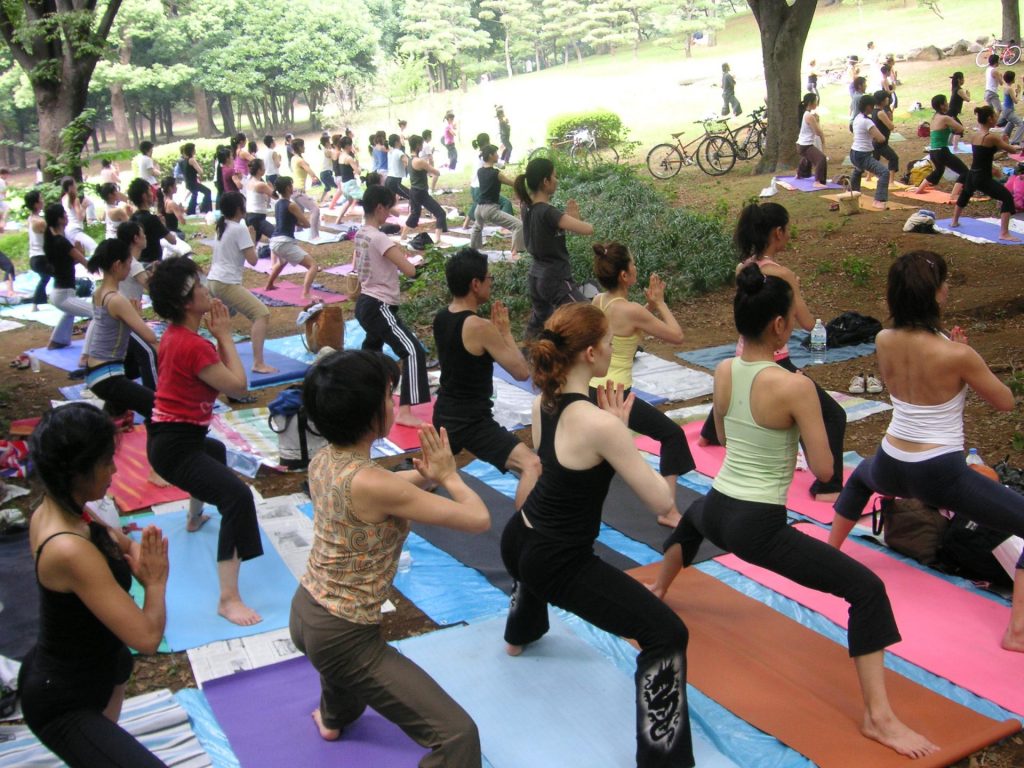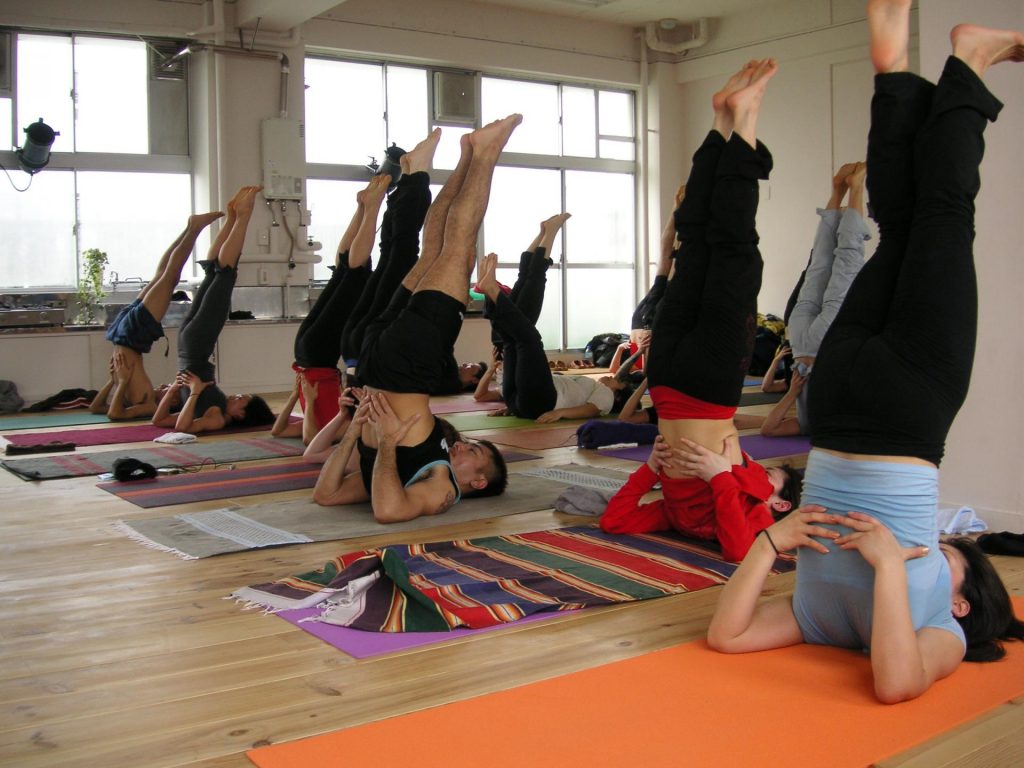People are turning to yoga in record numbers as the ancient philosophy attracts a surprising mix of practitioners. Celebrities, surfers and office workers are finding yoga creates a physical and spiritual compass to help navigate today’s hectic world.

In the past two years dozens of yoga studios have opened in Tokyo alone. It has become one of the fastest growing lifestyle sectors right across the country, promoting a healthy alternative to the sometimes stressful pace of modern day living in Japan.
The authenticity of yoga in Japan was questioned in 1995 when the infamous Aum Shinrikyu (Aum Supreme Truth), carried out poison gas attacks in Tokyo subways. The cult reportedly used yoga as one of the methods to attract new followers. This consequently stunted the growth of yoga in the country for several years.
People begin studying yoga for various reasons; some are drawn to the physical benefits, some to enhance psychological well being, while others practice to cultivate spiritual growth. The ultimate goal is to create unity among all three—the mind, body and spirit.
There are proven physical and psychological benefits to training in the discipline, but the yogic lifestyle which encourages self-awareness, self-discipline and living in harmony with the surroundings, is a path more and more people are following.

Is it all the same?
Yoga is not new. It has been around for thousands of years. It has, however, always been an evolving discipline, and new forms of yoga are developing all the time. The physical practice of yoga is mostly based on postures borrowed from Hatha Yoga. The word hatha combines two Sanskrit words: ha, meaning “the breath of the sun,” and tha, which means “the breath of the moon.” This major branch of yoga emphasizes physical practice, the body as a vehicle for the spirit, and is known as “the path of rigorous discipline.”
Other not yet widely recognized branches of yoga include Jnâna-Yoga (the path of wisdom), Karma-Yoga (the path of selfless action), Bhakti-Yoga (the path of devotion), Mantra-Yoga (the discipline of concentration), Raja-Yoga (the eight-limbed psycho-physical path) and Tantra-yoga (the discipline of ritual).
Within Hatha Yoga there are a few modern variations. Some of the more prominent ones include Sivananda Yoga, encompassing a mixture of the physical practice, meditation and breath control. Ananda Yoga is gentler and more contemplative, while Iyengar Yoga emphasizes anatomical alignment.
There have always been many teachers who are inspired by no direct association to any tradition. These styles are sometimes referred to as “free style Hatha Yoga.” Traditions and styles are constantly changing to satisfy a search for a deeper meaning and the dynamic possibilities of yoga practice. Fusions of styles and new techniques sometimes also incorporate martial arts or dance.
Getting your feet wet
There are various reputable studios in and around Tokyo and other major metropolitan areas. Yoga is offered at most fitness clubs as well. Experimenting with different teachers and styles will help you get acquainted with what is out there. Find a situation that suits you and your schedule, and keep an open mind to experiment with other styles, based on your changing needs.
Keep in mind some traditions are more physically challenging than others. Ashtanga Vinyasa, for example, offers a comprehensive series of fixed sequences practiced according to level of experience and ability. Some fitness club yoga is labeled “Power Yoga.” It tends to draw inspiration from strong Hatha Yoga and is usually more accessible to beginners due to a focus on simple practical physical applications. Many studios and fitness clubs also offer a more relaxing “Gentle Yoga,” as well as “Hot Yoga” practiced in heated rooms.

Who’s getting yoga-fied?
People doing yoga come from all walks of life. Corporate types are drawn by the balancing effect it can have on busy lives. Graphic designers, construction workers, system engineers, high school students, musicians and others all do yoga. Soon-to-be mothers and many athletes also participate. Regular yoga practice complements all kinds of sports activity. It enhances performance, balance, flexibility, concentration and physical strength.
Kelly Slater, Rickson Gracie, Sophie Anderton, Madonna, Geri Halliwell, Emma Jones, Sting, Sadie Frost, Mike D and Willem Dafoe are just a few famous yoga enthusiasts.
Whether you work out regularly, are hoping to get into shape or are interested in making a lifestyle change, there are yoga classes out there appropriate for you. Starting next issue, we’ll shed more light on the yogic path, talk to people throughout the yoga community in Japan, get some instructor tips and try to answer some of your questions in our new regular yoga column here in Outdoor Japan. Until then…
Patrick Oancia is the director and head teacher of YogaJaya in Tokyo. The Hong Kong born Romanian/Spanish/Canadian has been based in Japan for 18 years, practicing Raja Yoga for the past 10 years. Patrick is a keen snowboarder who is also active in music production, live performance, DJ-ing and pursues interest in all facets of art and design. Patrick welcomes comments and questions. You can email him directly at patrick@outdoorjapan.com.
The Eight Limbs of Raja Yoga
The most commonly known form of yoga is asana; the physical poses. Asana, however, is just one step in the ancient system expounded by the sage Pantajali in his Yoga Sutras. Patanjali, the father of classical yoga, collected and compiled ancient techniques to reach spiritual freedom. His road map elaborated upon a system of eight steps to reach yoga’s ultimate goal. The limbs are steps along the path of personal development, to achieve harmony of the mind, body and spirit, eventually leading to enlightenment. Hatha Yoga masters also later utilized the yoga sutras for still meditation.
Yama: The five yamas relate to a code of conduct and attitude towards others and the world around you.
Niyama: The five niyamas focus on our attitude toward ourselves such as self-respect, and outer and inner cleanliness.
Asana: The physical postures. The asanas are designed to sharpen the mind through physical practice, also reliving tension and stress.
Pranayama: Controlled breathing to calm the mind and focus energy.
Pratyahara: Withdrawal of the senses. To be so immersed in meditation, breathing or physical poses that you turn inward and shut out any outside influences.
Dharana: Training the mind to focus without distraction. Practicing one-pointedness of mind.
Dhyana: Meditation. Stilling the mind, uninterrupted concentration aimed at heightening one’s awareness.
Samadhi: The ultimate goal of the Eight Limbs of Yoga: the super conscious state of quiet, blissful awareness.
Yoga Roots
Due to the oral transmission and the secretive nature of the teachings, yoga’s history has been somewhat difficult to trace. Early writings were transcribed on fragile palm leaves that were easily damaged, destroyed or lost, yet yoga’s development can be traced back more than 5,000 years ago to sacred texts used by Brahman Vedic priests in India. More information on the history of yoga is available online.
Benefits of Practicing Yoga
Yoga stabilizes the autonomic nervous system equilibrium, decreases the respiratory rate and blood pressure, increases respiratory and cardiovascular efficiency, musculoskeletal flexibility joint range of motion improves, and the list goes on.
The psychological benefits of yoga range from improvement of somatic and kinesthetic awareness and enhanced memory function to increased learning efficiency. It is also clinically proven to decrease anxiety and depression.
Modern Styles of Hatha Yoga
Ananda Yoga, Anusara Yoga, Ashtanga Vinyasa Yoga, Bikram Yoga, Integral Yoga, Iyengar Yoga, Kripalu Yoga, Kundalini Yoga, Sivananda Yoga, Svaroopa Yoga, Viniyoga and Bharata Yoga.





